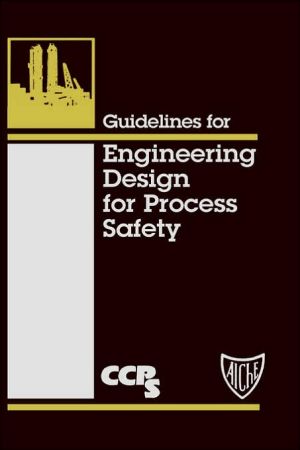

 |

|

Sold Out
Book Categories |
List of Tables.
List of Figures.
Preface.
Glossary.
Acronyms and Abbreviations.
1. INTRODUCTION.
1.1 Objectives.
1.2 Scope.
1.3 Applicability.
1.4 Organization of This Book.
1.5 References.
2. INHERRENTLY SAFER PLANTS.
2.1 Introduction.
2.2 Intensification.
2.3 Substitution.
2.4 Attenuation.
2.5 Limitation of Effects.
2.6 Simplification and Error Tolerance.
2.7 Inherent Safety Checklist.
2.8 Summary—A Fable.
Appendix 2A. Inherent Process Safety Checklist.
2.9 References.
3. PLANT DESIGN.
3.1 Process Safety Review Through the Life of the Plant.
3.2 Process Design.
3.3 Site Selection and Evaluation.
3.4 Plant Layout and Plot Plan.
3.5 Civil Engineering Design.
3.6 Structural Engineering Design.
3.7 Architectural Design.
3.8 Plant Utilities.
3.9 Plant Modifications.
3.10 References.
4. EQUIPMENT DESIGN.
4.1 Introduction.
4.2 Loading and Unloading Facilities.
4.3 Material Storage.
4.4 Process Equipment.
4.5 References.
5. MATERIALS SELECTION.
5.1 Introduction.
5.2 Corrosion.
5.3 Design Considerations.
5.4 Fabrication and Installation.
5.5 Corrosion Monitoring and Control Techniques.
5.6 References.
6. PIPING SYSTEMS.
6.1 Introduction.
6.2 Detailed Specification.
6.3 Specifying Valves to Increase Process Safety.
6.4 Joints and Flanges.
6.5 Support and Flexibility.
6.6 Vibration.
6.7 Special Cases.
Appendix 6A. Examples of Safety Design Concerns.
6.8 References.
7. HEAT TRANSFER FLUID SYSTEMS.
7.1Introduction.
7.2 General Description of Heat Transfer Fluids.
7.3 System Design Considerations.
7.4 Heat Transfer Fluid System Components.
7.5 Safety Issues.
7.6 References.
8.THERMAL INSULATION.
8.1 Properties of Thermal Insulation.
8.2 Selection of Insulation System Materials.
8.3 Corrosion under Wet Thermal Insulation.
8.4 References.
9. PROCESS MONITORING AND CONTROL.
9.1 Introduction.
9.2 Instrumentation.
9.3 Process Monitoring Using Computer-Based Systems.
9.4 Alarm Systems Philosophy.
9.5 Safety System Maintenance Testing.
9.6 Implementing the Process Control System.
9.7 Summary.
Appendix 9A. Safety Considerations for Monitoring and Control.
Appendix 9B. Instrumentation and Control Checklist.
9.8 References.
10. DOCUMENTATION.
10.1 Design.
10.2 Operations.
10.3 Maintenance.
10.4 Records Management.
Appendix 10A. Typical Inspection Points and Procedures.
10.5 References.
11. SOURCES OF IGNITION.
11.1 Introduction.
11.2 Types of Ignition Source.
11.3 Ignition by Flames.
11.4 Spontaneous Ignition (Autoignition).
11.5 Electrical Sources.
11.6 Physical Sources.
11.7 Chemical Reactions.
11.8 Design Alternatives.
11.9 References.
12. ELECTRICAL SYSTEM HAZARDS.
12.1 Electrical Equipment Hazards.
12.2 Lightning Protection.
12.3 Bonding and Grounding.
12.4 References.
13. DEFLAGRATION AND DETONATION FLAME ARRESTERS.
13.1 Definitions and Explanations of Terms.
13.2 Introduction.
13.3 Types of Flame Arresters.
13.4 Regulatory Use, Testing and Certification.
13.5 Application Considerations.
13.6 Special Applications and Alternatives.
13.7 Conclusions.
13.8 Future Developments.
13.9 References.
14. PRESSURE RELIEF SYSTEMS.
14.1 Introduction.
14.2 Relief Design Scenarios.
14.3 Pressure Relief Devices.
14.4 Sizing of Pressure Relief System.
14.5 Design of Relief Devices: Other Considerations.
14.6 DIERS Methods of Overpressure Protection for Two-Phase Flows.
14.7 Emergency Depressuring.
14.8 References.
15. EFFLUENT DISPOSAL SYSTEMS.
15.1 Flare Systems.
15.2 Blowdown Systems.
15.3 Incineration Systems.
15.4 Vapor Control Systems.
15.5 References.
16. FIRE PROTECTION.
16.1 Introduction.
16.2 Detection and Alarm Systems.
16.3 Water-Based Fire Protection Systems.
16.4 Chemical and Special Agent Extinguishing Systems.
16.5 Passive Fire Protection.
16.6 References.
17. EXPLOSION PROTECTION.
17.1 Introduction.
17.2 Energy Release on Noncombusive Vessel Rupture.
17.3 Flammability.
17.4 Flame Events.
17.5 Flammability Control Measures Inside Equipment.
17.6 Flame Mitigation Inside Equipment.
17.7 References.
Index.
Login|Complaints|Blog|Games|Digital Media|Souls|Obituary|Contact Us|FAQ
CAN'T FIND WHAT YOU'RE LOOKING FOR? CLICK HERE!!! X
 You must be logged in to add to WishlistX
 This item is in your Wish ListX
 This item is in your CollectionGuidelines for Engineering Design for Process Safety
X
 This Item is in Your InventoryGuidelines for Engineering Design for Process Safety
X
 You must be logged in to review the productsX
 X
 X

Add Guidelines for Engineering Design for Process Safety, Inherently safer plants begin with the initial design. Here is where integrity and reliability can be built in at the lowest cost, and with maximum effectiveness. This book focuses on process safety issues in the design of chemical, petrochemical, and hyd, Guidelines for Engineering Design for Process Safety to the inventory that you are selling on WonderClubX
 X

Add Guidelines for Engineering Design for Process Safety, Inherently safer plants begin with the initial design. Here is where integrity and reliability can be built in at the lowest cost, and with maximum effectiveness. This book focuses on process safety issues in the design of chemical, petrochemical, and hyd, Guidelines for Engineering Design for Process Safety to your collection on WonderClub |